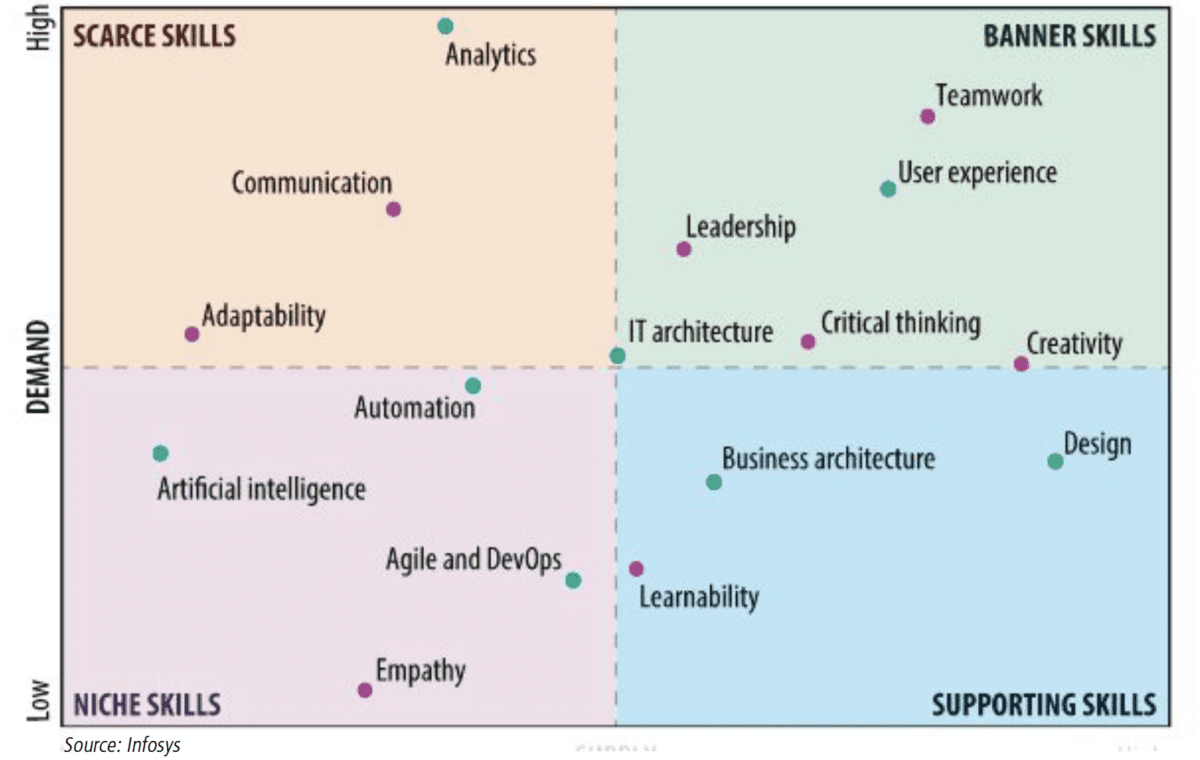In a time of skills scarcity, leading organizations are adopting a multi-dimensional approach to talent acquisition and development.
By Jeff Kavanaugh
Organizations are struggling to find talent with the right skills to meet digital business needs. This trend led the Infosys Knowledge Institute to conduct a worldwide study of more than 1,000 senior management executives globally. The research shows that today’s digital environment is calling for new skills, producing talent gaps that organizations have to fill. What else did it discover? Here are five key takeaways from the recent study.
1. Analytical skills are scarce. The practical importance of hard and soft skills is driven by their relative scarcity -the balance between demand and availability. The survey found that while 66 percent of digital initiatives require analytical skills, they are scarcest among the technical skills of the workforce. Applicants with the deep expertise of data scientists are especially rare.
Additionally, artificial intelligence skills are in short supply, but the relative demand is lower due to the technology’s earlier stage of maturity and deployment (see Figure 1). User experience skills are also highly sought after for initiatives that focus on customers and their desired experience. While these individual skills are scarce in the market, it is even harder to find a single person with a strong mix of needed hard and soft skills.
2. Collaboration skills are more valued than individual skills. Teamwork and leadership are rated highly for digital projects, with more than 70 percent of HR leaders reporting a need for these skills. Digital transformation projects are complex and call for large teams, and success depends on team members exhibiting these qualities. In contrast, executives did not rate empathy highly outside of customer experience initiatives. This is short-sighted because as artificial intelligence proliferates, empathy will be essential to success.
Unlike technical skills, soft skills, once developed and practiced, continue to stay relevant. These are skills which are innate to some extent, yet many leaders believe they can be developed with the right training and mentoring.
Soft skills have become so important that some businesses use tools to test whether candidates are well-rounded. For example, AQAL Capital, a German firm that invests in sustainability-focused startups, tests executives for three skills -collaboration, contextual thinking, and cognitive complexity -to see whether they will fit with rest of the management team.
3. Organizations face tangible barriers to talent transformation. There’s no shortage of challenges when it comes to reskilling the workforce. Lack of budget is the biggest barrier to learning and development efforts, followed by lack of management awareness or support, organizational issues, inadequate talent management plans, and insufficient HR resources. These barriers are related, as companies consistently undervalue and underfund talent and employee initiatives, ultimately undermining their future prospects. Companies must treat talent initiatives as investments -not expenses -for these have long-term implications every bit as much as a long-lived physical asset.

As Ravi Kumar S, president of Infosys, says: “The individuals who will flourish in the digital economy are the ones who can learn to learn, learn to unlearn, and learn to relearn.” While the research has shown learning to be a core of all other skills, companies tend to focus on acquiring skills for a particular purpose or project rather than as a foundation for long-term success.
4. Leading organizations seek talent from all sources and cast a wider net for new hires. The best companies hire from multiple sources, including community college, vocational or trade schools, and those returning to the workforce after military service or taking leave to focus on family. Leading companies also partner with academia in strategic and innovative ways to jointly develop new talent.
For example, Infosys has partnered with Trinity College, one of the leading liberal arts schools in the U.S., to bring liberal arts majors into digital roles. Together, Infosys and Trinity are creating agile developers or new-age business analysts.
But college recruiting is not enough. A strategic planning advisor of a large American oil and gas corporation in the U.S. commented within the study: “One of the things we recommended in our workforce planning study was to be open about the way we source and not just rely on college recruiting, because you can only go so far with that. We’re probably missing out on some talent that could add greater diversity to the way we work.”
5. Leading organizations engage temporary workers and the gig economy strategically. Besides partnering with academia to jointly develop new talent, leading companies are also more likely to leverage temporary workers to fill talent gaps. The most successful organizations have better processes to engage and manage this segment of the workforce. However, this strategic approach requires strong internal operations to contract, integrate, manage, and release these workers as projects spin up and then wind down.
The reasons companies turn to temporary staff vary by industry. For example, the survey finds that high-tech companies use temporary staff for technical skills on 95 percent of their digital initiatives versus the overall industry average of 74 percent. Manufacturers use temporary workers for design capabilities on 70 percent of these projects versus an all-industry average of 52 percent. And life sciences companies contract externally for business or industry expertise in 48 percent of their digital transformations.
Perhaps the most important characteristic of companies that are successful in getting the skills they need is that they embrace multiple approaches for developing and managing talent. Think of this as a duality: two non-similar perspectives that exist in harmony to achieve a common purpose.
For example, companies both:
- hire and develop talent;
- employ and contract workers;
- recruit bachelor’s and associate degree holders;
- look for hard and soft skills; and
- provide classroom and virtual training.
At a time when talent is scarce and getting scarcer, being able to tackle multiple strategies simultaneously might be the critical differentiator for companies to meet their talent demands.
Jeff Kavanaugh is vice president and executive editor at the Infosys Knowledge Institute, the research arm of Infosys.















